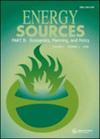Asymmetric co-integration relationship among coal production, real estate development, and CO2 emissions in China
IF 2.2
4区 工程技术
Q3 ENERGY & FUELS
Energy Sources Part B-Economics Planning and Policy
Pub Date : 2022-04-17
DOI:10.1080/15567249.2022.2053247
引用次数: 2
Abstract
ABSTRACT The real estate industry is associated with coal production and CO2 emissions. The nonlinear ARDL (AutoRegressive Distributed Lag) co-integration method was used to analyze the effects of long-term and short-term real estate development and CO2 emissions on coal production. The results showed that: (1) The positive and negative impacts of CO2 emissions on coal production were similar in the long. Moreover, CO2 emissions negatively affected coal production; (2) In the long run, the positive impact of real estate development on coal production is greater than the negative impact, though it is not significant. In the short term, the negative shock of real estate effectively reduced coal production; (3) The impact of coal production on CO2 emissions is symmetric in both the long and short term. Therefore, in the future, real estate should develop moderately. In addition, lessening coal production demand is crucial to ensure coal production reduction and carbon neutrality.中国煤炭生产、房地产开发与二氧化碳排放的非对称协整关系
房地产行业与煤炭生产和二氧化碳排放有关。采用非线性自回归分布滞后(ARDL)协整方法分析了长期和短期房地产开发以及二氧化碳排放对煤炭生产的影响。结果表明:(1)长期来看,CO2排放对煤炭生产的正、负影响相似。此外,二氧化碳排放对煤炭生产产生负面影响;(2)从长期来看,房地产开发对煤炭生产的积极影响大于消极影响,但不显著。短期来看,房地产的负面冲击有效降低了煤炭产量;(3)煤炭生产对二氧化碳排放的影响在长期和短期内都是对称的。因此,未来房地产应该适度发展。此外,减少煤炭生产需求对于确保煤炭减产和碳中和至关重要。
本文章由计算机程序翻译,如有差异,请以英文原文为准。
求助全文
约1分钟内获得全文
求助全文
来源期刊

Energy Sources Part B-Economics Planning and Policy
ENERGY & FUELS-
CiteScore
6.80
自引率
12.80%
发文量
42
审稿时长
6-12 weeks
期刊介绍:
12 issues per year
Abstracted and/or indexed in: Applied Science & Technology Index; API Abstracts/Literature; Automatic Subject Index Citation; BIOSIS Previews; Cabell’s Directory of Publishing Opportunities in Economics and Finance; Chemical Abstracts; CSA Aquatic Science & Fisheries Abstracts; CSA Environmental Sciences & Pollution Management Database; CSA Pollution Abstracts; Current Contents/Engineering, Technology & Applied Sciences; Directory of Industry Data Sources; Economic Abstracts; Electrical and Electronics Abstracts; Energy Information Abstracts; Energy Research Abstracts; Engineering Index Monthly; Environmental Abstracts; Environmental Periodicals Bibliography (EPB); International Abstracts in Operations Research; Operations/Research/Management Science Abstracts; Petroleum Abstracts; Physikalische Berichte; and Science Citation Index.
Taylor & Francis make every effort to ensure the accuracy of all the information (the "Content") contained in our publications. However, Taylor & Francis, our agents, and our licensors make no representations or warranties whatsoever as to the accuracy, completeness, or suitability for any purpose of the Content. Any opinions and views expressed in this publication are the opinions and views of the authors, and are not the views of or endorsed by Taylor & Francis. The accuracy of the Content should not be relied upon and should be independently verified with primary sources of information. Taylor & Francis shall not be liable for any losses, actions, claims, proceedings, demands, costs, expenses, damages, and other liabilities whatsoever or howsoever caused arising directly or indirectly in connection with, in relation to, or arising out of the use of the Content. Terms & Conditions of access and use can be found at http://www.tandfonline.com/page/terms-and-conditions .
 求助内容:
求助内容: 应助结果提醒方式:
应助结果提醒方式:


